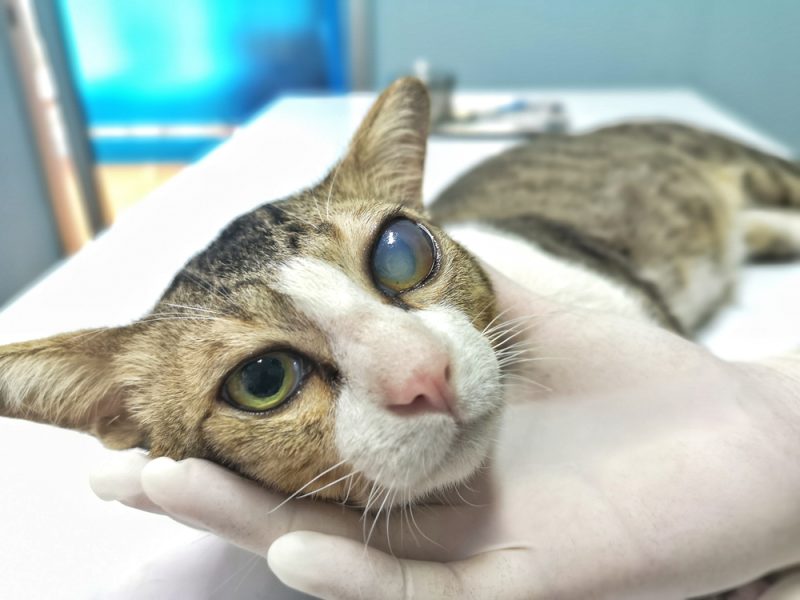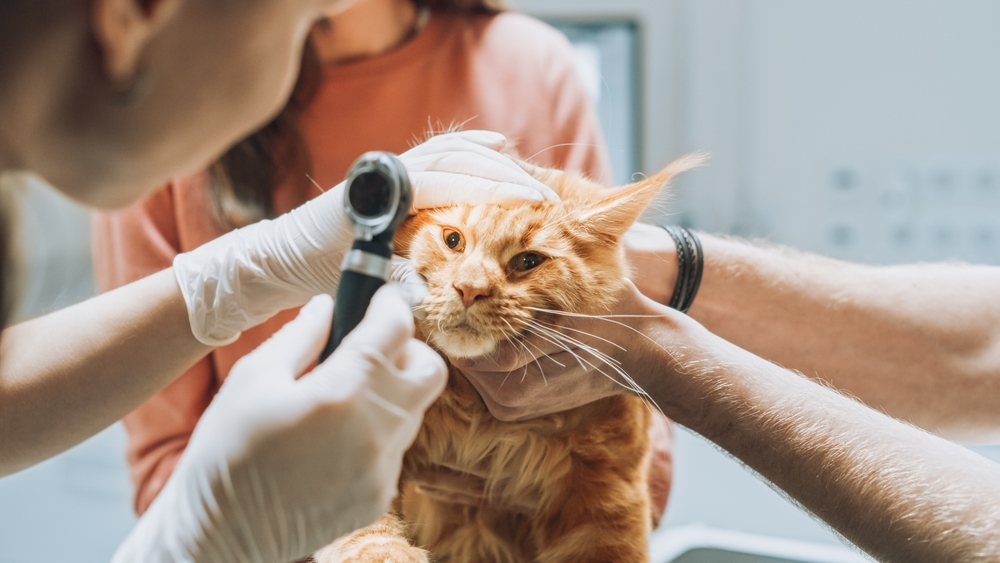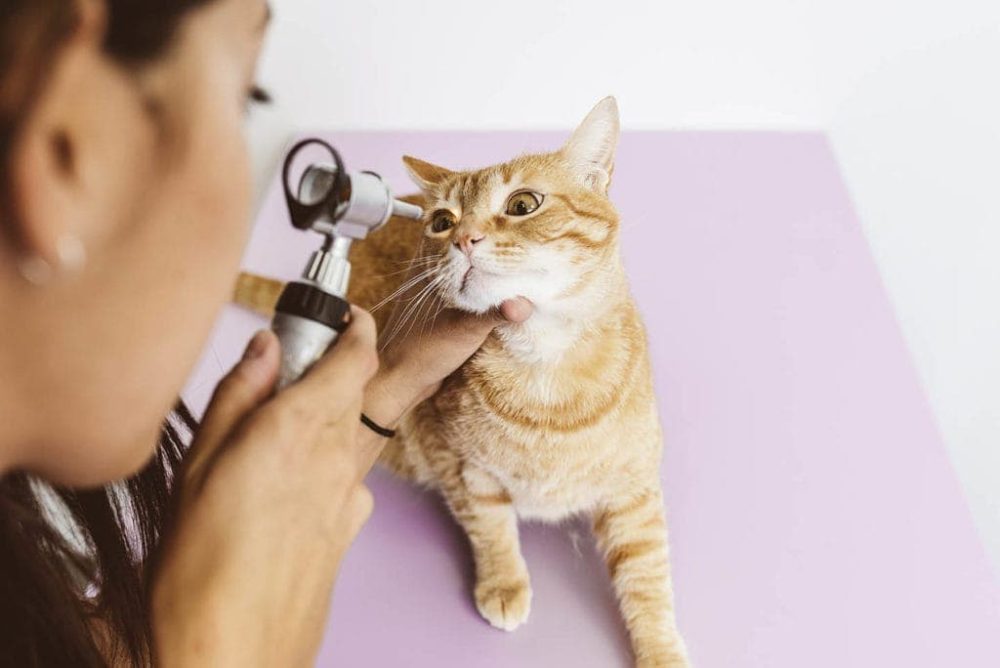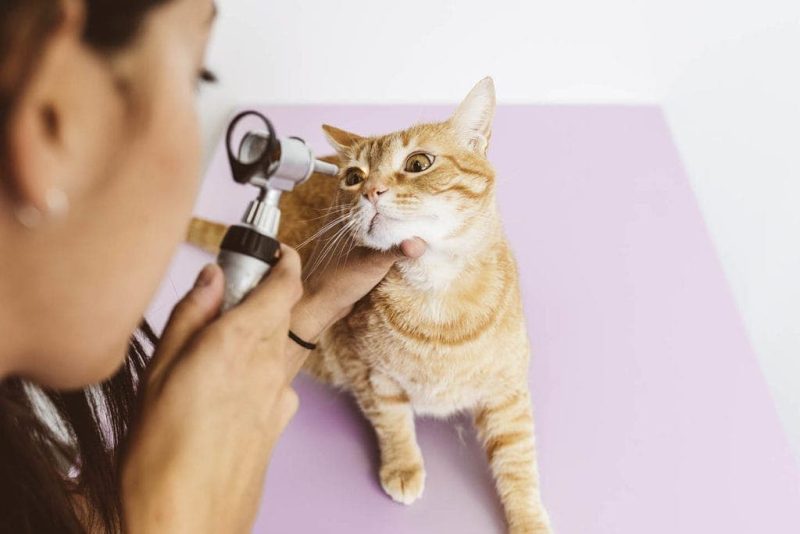Click to Skip Ahead
The eyes are often called, “the windows to the soul,” and this is also true for our feline friends. We can decipher how our cat is feeling just by the appearance of their eyes. Bright, round, responsive eyes may indicate that your cat is feeling great. Persistently squinty, tightly closed, watery eyes may indicate a health problem. As their owner, you should know what is normal and abnormal for your cat. Untreated eye issues can lead to blindness or even the loss of an eye.

What Is a Corneal Ulcer?
A corneal ulcer is a breach in the integrity of the clear membrane on the surface of the eyeball. The cornea is a thin, protective membrane composed of three layers: the outermost layer, known as the epithelium; the middle layer, which is the stroma; and the innermost layer, called Descemet’s membrane.
An ulcer can occur through the first few layers of the corneal epithelium, which is known as a simple ulcer or abrasion, or it can occur deeper, involving the epithelium and the stroma. An eye with an ulcer may appear cloudy due to the absorption of tears in the stroma layer. A much more serious issue can occur if the ulcer penetrates through the innermost layer of the cornea. When this happens, it is called a descemetocele. If this layer ruptures, the fluid from the eye can leak out, which collapses the eye and causes irreversible damage.

What Are the Signs of a Corneal Ulcer?
- Squinting
- Rapid blinking
- Tightly closed eyelids
- Pawing at the eye
- Rubbing the eye on an object
- Eye discharge or drainage
- Eye cloudiness
Corneal ulcers are painful, which is why a cat may exhibit these behaviors to try to relieve the pain.
What Causes a Corneal Ulcer?
- Trauma
- Foreign body
- Chemical burn
- Bacteria
- Viruses
- Endocrine disease
Injury to the cornea can occur through play, squabbling with another cat, rubbing the eye on a rough surface, or getting poked by a thorn or a stick. Shampoos and other liquids and chemicals that get into the eye may irritate and burn the cornea. Certain bacterial and viral illnesses, such as feline herpes virus, can affect the eyes, leading to ulcers. Other diseases like diabetes mellitus and keratoconjunctivitis sicca (dry eye) or breed-specific ailments, such as Manx stromal dystrophy, can all lead to corneal injury and ulcer formation.

How Do I Care for a Cat With a Corneal Ulcer?
If your cat displays signs of a possible eye issue, it is recommended to schedule a veterinary exam as soon as possible. Your veterinarian will gather a detailed medical history and conduct a thorough physical examination, paying special attention to the eyes.
Superficial ulcers may not be visible to the naked eye, so a special dye, known as fluorescence stain, may be used. The stain adheres to the ulcer in the cornea, which makes it fluorescent green and readily visible. Small ulcers may need to be seen with the use of an ophthalmoscope light and filter. Deep or chronic ulcers may need to be sampled for bacteria, or cultured, to target an appropriate therapy.
Superficial abrasions or simple ulcers typically heal within 3 to 5 days. Your veterinarian may prescribe antibiotic eye drops or ointments and pain-relieving drops to prevent infection and relieve pain. Other methods of pain control may include nonsteroidal anti-inflammatory drugs or pain relievers like gabapentin. Deep ulcers and descemetoceles may require surgery to protect the eye and promote healing. This can involve suturing the third eyelid over the ulcer or suturing the eyelids closed for a few days to allow the ulcer to heal. Depending on the severity of the ulcer, it may take 1 to 8 weeks for an ulcer to completely heal after being treated.
Neovascularization may occur during the healing process. This is when new blood vessels form across the surface of the cornea to the ulcer. The vessels may remain on the cornea after healing is complete. If the vessels are extensive, it may interfere with vision. Topical corticosteroids may be used after the ulcer is completely healed to help decrease the size of the vessels.

Frequently Asked Questions (FAQ)
Can an Untreated Ulcer Worsen?
Yes, ulcers can progress and may lead to blindness. Even treated ulcers need careful monitoring to ensure that healing is headed in the right direction.
How Will I Know When the Ulcer Has Healed?
Your veterinarian will repeat the fluorescein stain test. When the stain no longer adheres to a specific area on the cornea, it suggests that healing has taken place.
Can Steroid Eye Medication Be Used on an Active Eye Ulcer?
No. Steroid eye medication should be avoided because it can slow healing and worsen the ulcer.

Conclusion
Cats displaying signs of eye discomfort or pain should be evaluated by a veterinarian as soon as possible. Corneal ulcers may need to be treated with antibiotic eye medication and pain relievers. More serious eye ulcers may require surgical intervention to promote healing. Untreated, progressive ulcers may lead to the loss of the eye. Frequent check-ups with your veterinarian are necessary to ensure that the ulcer is healing properly.
Featured Image Credit: santypan, Shutterstock












